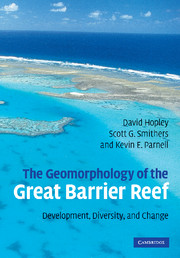Book contents
- Frontmatter
- Contents
- Preface
- Acknowledgements
- 1 Geomorphology and the Great Barrier Reef
- 2 Foundations of the Great Barrier Reef
- 3 Sea level: a primary control of long-term reef growth and geomorphological development
- 4 Oceanography, hydrodynamics, climate, and water quality as influences on reef geomorphological processes
- 5 Spatial analysis of the morphology of the reefs and islands of the Great Barrier Reef
- 6 The non-reefal areas of the continental shelf
- 7 Fringing and nearshore coral reefs
- 8 The mid-shelf reefs of the Great Barrier Reef
- 9 The coral reefs of the outer shelf of the Great Barrier Reef
- 10 Islands of the Great Barrier Reef
- 11 The accumulation of the Holocene veneer to the Great Barrier Reef
- 12 The Holocene evolution of the Great Barrier Reef province
- 13 Geomorphology's contribution to the understanding and resolution of environmental problems of the Great Barrier Reef
- References
- Geographic index
- Subject index
13 - Geomorphology's contribution to the understanding and resolution of environmental problems of the Great Barrier Reef
Published online by Cambridge University Press: 22 August 2009
- Frontmatter
- Contents
- Preface
- Acknowledgements
- 1 Geomorphology and the Great Barrier Reef
- 2 Foundations of the Great Barrier Reef
- 3 Sea level: a primary control of long-term reef growth and geomorphological development
- 4 Oceanography, hydrodynamics, climate, and water quality as influences on reef geomorphological processes
- 5 Spatial analysis of the morphology of the reefs and islands of the Great Barrier Reef
- 6 The non-reefal areas of the continental shelf
- 7 Fringing and nearshore coral reefs
- 8 The mid-shelf reefs of the Great Barrier Reef
- 9 The coral reefs of the outer shelf of the Great Barrier Reef
- 10 Islands of the Great Barrier Reef
- 11 The accumulation of the Holocene veneer to the Great Barrier Reef
- 12 The Holocene evolution of the Great Barrier Reef province
- 13 Geomorphology's contribution to the understanding and resolution of environmental problems of the Great Barrier Reef
- References
- Geographic index
- Subject index
Summary
Introduction
In Chapter 1 geomorphology was presented as a spatial science with a unique temporal scale which lies between ecological and geological studies. This book has adopted a spatial scale related to a cross-shelf gradient with the two main driving forces behind the present geomorphology of the Great Barrier Reef (GBR) being sea-level change which approaches a geological timescale and oceanography which is essential for understanding at an ecological scale. Geomorphological processes can be derived either from analysis of the evolution of landforms, largely the focus of this book and summarized in Chapter 11, or from measurement and monitoring of processes operating at the present time. Unfortunately, such monitoring, for example of sedimentation rates, has had only a short history on the GBR and on reefs worldwide in comparison to the measurement of terrestrial, coastal, and fluvial processes. Reefs respond rapidly to environmental change and the measurement of present geomorphological processes may incorporate much variability for which the longer record from dated sedimentary sequences can provide a benchmark. This is particularly important at a time when anthropogenic impact on the Reef is being widely reported (e.g., Bellwood et al., 2004; Fabricius, 2004).
If geomorphological studies of the development of the GBR over the last 10 ka, and especially over the last 6.5 ka since sea level stabilized, can provide this benchmark against which changes can be measured, then they have a vital role in contributing to the management process.
- Type
- Chapter
- Information
- The Geomorphology of the Great Barrier ReefDevelopment, Diversity and Change, pp. 431 - 468Publisher: Cambridge University PressPrint publication year: 2007



